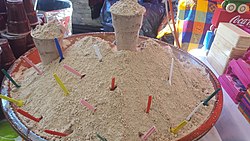Pinole
 Pinole (in tin) and milk | |
| Type | Ingredient |
|---|---|
| Region or state | Latin America |
| Main ingredients | Maize and cacao |
| Similar dishes | Gofio |
Pinole, also called pinol, is roasted ground maize. The resulting powder is then used as a nutrient-dense ingredient to make different foods, such as cereals, baked goods, tortillas, and beverages.[1] For example, it can be mixed with a combination of cocoa, agave, cinnamon, chia seeds, vanilla, or other spices, to make a beverage called pinolillo. The name comes from the Nahuatl word pinolli, meaning cornmeal. Today, pinole is generally made by hand using wood-burning adobe ovens and a stone and pestle, and is still consumed in certain, often rural, parts of Latin America. Pinole is considered the national beverage of Nicaragua.
Nutritional content
[edit]
Depending on the type of pinole and the quality of its ingredients, pinole can be high in key vitamins and nutrients, including protein, amino acids, fiber, and antioxidants.[2] For many indigenous peoples of Mexico and Central America, it is relied upon as a key source of nutrition and sustenance.[3]
Uses
[edit]Tarahumara people
[edit]Along with chia, pinole is a staple food of Rarámuri (Tarahumara) people,[4][5] an indigenous people of the Copper Canyon of Mexico. The name Rarámuri means "footrunners".[6] Noted for physical stamina and their ability to run extraordinarily long distances[7] wearing only huarache sandals with soles made of recycled tire treads and their traditional garb of a white cotton loincloth with a woven belt,[8] the Rarámuri consume bajíachi (corn beer) and pinole before races.[9][10]
In other folklore
[edit]The recorded history of Pinole, California, dates back to the early 1700s, when a Spanish commandant, Don Pedro Fages, led an exploration through the Contra Costa shoreline of California.[11] With a small band of soldiers and an Indian guide, Don Pedro Fages left Monterey and traveled northward until he reached the area known today as Pinole.[11] According to legend, the soldiers ran out of provisions on their march and found a village of Indians who gave them food.[11] This food consisted of a form of meal, made from acorns, seeds, and wild grain, which they called “pinole” (derived from the Aztec word pinolli, meaning ground and toasted grain or seeds.) [11] Thus, the soldiers named their camp “El Pinole,” and Pinole received its name.[11]
Commercial products
[edit]Authentic pinole can occasionally be found in rural markets throughout Mexico and Central America. It is generally made by hand and sold as a powder in burlap pouches. A sugar-heavy, mass-market version can also sometimes be found in Latin American supermarkets under brands such as Don Julio.
See also
[edit]References
[edit]- ^ "The No Meat Athlete". Nomeatathlete.com. 2 December 2009.
- ^ "Benefits of Pinole". Livestrong Foundation. 2015. Retrieved 1 June 2015.
- ^ "What is Pinole". Wisegeek.com. 2015. Retrieved 1 June 2015.
- ^ John G. Kennedy (1990). The Tarahumara. Chelsea House. p. 106. ISBN 978-1-55546-730-2.
- ^ Bernard L. Fontana (15 December 2016). Tarahumara: Where Night is the Day of the Moon. University of Arizona Press. p. 60. ISBN 978-0-8165-3661-0.
- ^ Américas. Organization of American States. 1990. p. 12.
- ^ Fructuoso Irigoyen-Rascón; Alfonso Paredes (13 October 2015). Tarahumara Medicine: Ethnobotany and Healing Among the Rarámuri of Mexico. University of Oklahoma Press. p. 89. ISBN 978-0-8061-5271-4.
- ^ Manuela Fischer; Michael Kraus (15 July 2015). Exploring the Archive: Historical Photography from Latin America. The Collection of the Ethnologisches Museum Berlin. Böhlau Verlag Köln Weimar. p. 340. ISBN 978-3-412-22415-8.
- ^ Esther Schader (29 March 1997). "Making Strides for Survival: Family Aids Poor Mexican Tribe Famed for Running". Los Angeles Times. Archived from the original on July 4, 2019.
- ^ Fructuoso Irigoyen-Rascón; Alfonso Paredes (13 October 2015). Tarahumara Medicine: Ethnobotany and Healing Among the Rarámuri of Mexico. University of Oklahoma Press. p. 88. ISBN 978-0-8061-5271-4.
- ^ a b c d e "History of Pinole". City of Pinole. 3 August 2024. Retrieved 3 August 2024.
Further reading
[edit]- Francisco J. Santamaría, Diccionario de mejicanismos, Mexico City: Editorial Porrúa, 1959, 1978.